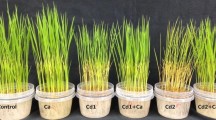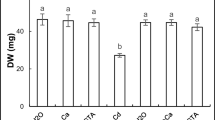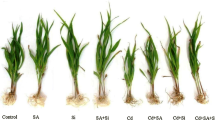Abstract
The present study was undertaken to examine the possible roles of calcium (Ca2+) and silica (Si) in protection against oxidative damage due to Cd2+ toxicity in rice (Oryza sativa L.) seedlings grown in hydroponics. Rice seedlings raised for 12 days in hydroponics containing Cd(NO3)2 (75 μM) showed reduced growth; increase in the level of reactive oxygen species (ROS) (O2 ·− and H2O2), thiobarbituric acid reactive substances (TBARSs) and protein carbonylation; and increase in the activity of antioxidant enzymes—superoxide dismutase (SOD), catalase (CAT) and guaiacol peroxidase (GPX) compared to untreated controls. Exogenously added Ca2+ (2 mM) and Si (200 μM) significantly alleviated negative effect of Cd2+ by restoration of growth of the seedlings, suppression of Cd2+ uptake and restoration of root plasma membrane integrity. The levels of O2 ·−, H2O2, lipid peroxidation and protein carbonyls were much lower when Ca2+ and Si were added in the growth medium along with Cd2+ as compared to Cd-alone-treated seedlings. Ca2+ and Si lowered Cd-induced increase in SOD, GPX and APX activities while they elevated Cd-induced decline in CAT activity. Using histochemical staining of O2 ·− and H2O2 in leaf tissues, it was further confirmed that added Ca2+ and Si suppressed Cd-induced accumulation of O2 ·− and H2O2 in the leaves. The results suggest that exogenous application of Ca2+ and Si appears to be advantageous for rice plants in alleviating Cd2+ toxicity effects by reducing Cd2+ uptake, decreasing ROS production and suppressing oxidative damage. The observations indicate that Ca2+ and Si treatments can help in reducing Cd2+ toxicity in rice plants.









Similar content being viewed by others
References
Aidid SB, Okamoto H (1993) Responses of elongation growth rate, turgor pressure and cell wall extensibility of stem cells of Impatiens balsamina to lead, cadmium and zinc. Biometals 6:245–249
Allen SE, Grimshaw HM, Rowland AP (1986) Chemical analysis. In: Mooren PD, Chapman SB (eds) Methods in plant ecology. Blackwell Scientific Publication, Oxford, pp 285–344
Andresen E, Küpper H (2013) Cadmium toxicity in plants. In: Sigel A, Sigel H, Sigel RKO (eds) Cadmium: from toxicity to essentiality. Metal Ions in Life Sciences 11:395–413
Beauchamp CO, Fridovich I (1971) Superoxide dismutase: improved assay and an assay applicable to acrylamide gels. Anal Biochem 44:276–287
Beers RF, Sizer IW (1952) Colorimetric method for estimation of catalase. J Biol Chem 195:133–139
Bradford MM (1976) A rapid and sensitive method for the quantification of microgram quantities of protein utilizing the principle of protein-dye binding. Anal Biochem 72:248–254
Clemens S (2006) Toxic metal accumulation, responses to exposure and mechanisms of tolerance in plants. Biochimie 88:1707–1719
Cramer GR (1985) Displacement of Ca2+ and Na+ form the plasma lemma root cells. Plant Physiol 79:207–211
Dat J, Vandenbeele S, Vranova E, Van Montagu M, Inze D, Van Breusegm F (2000) Dual action of the active oxygen species during plant stress responses. Cell Mol Life Sci 57:779–795
de Kok LJ, Kuiper PJC (1986) Effect of short-term dark incubation with chloride and selenate on the glutathione content of spinach leaf discs. Physiol Plant 68:477–482
Egley GH, Paul RN, Vaughn KC, Duke SO (1983) Role of peroxidase in the development of water impermeable seed coats in Sidaspinosa L. Planta 157:224–232
Farzadfar S, Zarinkamar F, Modarres-Sanavy SAM, Hojati M (2013) Exogenously applied calcium alleviates cadmium toxicity in Matricaria chamomilla L. plants. Environ Sci Pollut Res 20:1413–1422
Frahry G, Schopfer P (2001) NADH-stimulated, cyanide-resistant superoxide production in maize coleoptiles analysed with a tetrazolium-based assay. Planta 212:175–183
Gallego SM, Pena LB, Barcia RA, Azpilicueta CE, Iannone MF, Rosales EP, Zawoznik MS, Groppa MD, Benavides MP (2012) Unravelling cadmium toxicity and tolerance in plants: insight into regulatory mechanisms. Environ Exp Bot 83:33–46
Gill SS, Tuteja N (2010) Reactive oxygen species and antioxidant machinery in abiotic stress tolerance in crop plants. Plant Physiol Biochem 48:909–930
Griffith OW (1980) Determination of glutathione disulphide using glutathione reductase and 2-vinylpyridine. Anal Biochem 6:207–212
Hall JL (2002) Cellular mechanisms for heavy metal detoxification and tolerance. J Exp Bot 53(366):1–11
Hayat Q, Hayat S, Irfan M, Ahmad A (2010) Effect of exogenous salicylic acid under changing environment: a review. Environ Exp Bot 68:14–25
Heath RL, Packer L (1968) Photoperoxidation in isolated chloroplasts. Kinetics and stoichiometry of fatty acid peroxidation. Arch Biochem Biophys 125:189–198
Horst WJ, Fecht M, Naumann A, Wissemeier AH, Maier P (1999) Physiology of manganese toxicity and tolerance in Vigna unguiculata (L.) Walp. J Plant Nutr Soil Sci 162:263–274
Hossain MA, Nakano Y, Asada K (1984) Monodehydroascorbate reductase in spinach chloroplasts and its participation in regeneration of ascorbate for scavenging hydrogen peroxide. Plant Cell Physiol 25:385–395
Hossain MT, Ryuji M, Soga K, Wakabayashi K, Kamisaka S, Fuji S, Yamamoto R, Hoson T (2002) Growth promotion and increase in cell wall extensibility by silicon in rice and some Poaceae seedlings. J Plant Res 115:23–27
Iwasaki K, Maier P, Fecht M, Horst WJ (2002) Effects of silicon supply on apoplastic manganese concentrations in leaves and their relation to manganese tolerance in cowpea (Vigna unguiculata (L.) Walp.). Plant Soil 238:281–288
Jana S, Choudhuri MA (1981) Glycolate metabolism of three submerged aquatic angiosperms during aging. Aquat Bot 12:345–354
Klapheck S, Fliegner W, Zimmer I (1994) Hydroxymethyl-phytochelatins [(gamma- glutamyl-cysteine)n,-serine] are metal-induced peptides of the Poaceae. Plant Physiol 104:1325–1332
Law MY, Charles SA, Halliwell B (1983) Glutathione and ascorbic acid and spinach (Spinacea oleracea) chloroplasts: the effect of hydrogen peroxide and paraquat. Biochem J 210:899–903
Levine RL, Williams J, Stadtman ER, Shacter E (1994) Carbonyl assays for determination of oxidatively modified proteins. Methods Enzymol 233:346–357
Liang Y, Wong J, Wei L (2005) Silicon-mediated enhancement of cadmium tolerance in maize (Zea mays L.) grown in cadmium contaminated soil. Chemosphere 58:475–483
Mishra HP, Fridovich I (1972) The role of superoxide anion in autooxidation of the epinephrine and sample assay for SOD. J Biol Chem 247:3170–3175
Mittler R, Vanderauwera S, Gollery M, Van Breusegem F (2004) Reactive oxygen gene network of plants. Trends Plant Sci 9:490–498
Moller IM, Jensen PE, Hansson A (2007) Oxidative modifications to cellular components in plants. Ann Rev Plant Biol 58:459–481
Nakano Y, Asada K (1981) Hydrogen peroxide is scavenged by ascorbate-specific peroxidase in spinach chloroplasts. Plant Cell Physiol 22:867–880
Noctor G (2006) Metabolic signalling in defence and stress: the central roles of soluble redox couples. Plant Cell Environ 29:409–425
Polge C, Jaquinod M, Holzer F, Bourguignon J, Walling L (2009) Evidences for the existence in Arabidopsis thaliana of the proteasome proteolytic pathway activation in response to cadmium. J Biol Chem Mol Biol 284:35412–35424
Pompella A, Maellaro E, Casini AF et al (1987) Measurement of lipid peroxidation in vivo: a comparison of different procedures. Lipids 22:206–211
Pyngrope S, Bhoomika K, Dubey RS (2013) Oxidative stress, protein carbonylation, proteolysis, and antioxidative defense system as a model for depicting water deficit tolerance in Indica rice seedlings. Plant Growth Regul 69:149–165
Romero-Puertas MC, Gomez JM, del Rio A, Sandalio LM (2002) Cadmium causes the oxidative modification of proteins in pea plants. Plant Cell Environ 25:677–686
Romero-Puertas MC, Rodriguez-Serrano M, Corpas FJ, Gomez M, del Rio LA, Sandalio LM (2004) Cd-induced subcellular accumulation of O2 − and H2O2 in pea leaves. Plant Cell Environ 27:1122–1134
Sandalio L, Dalurzo H, Gomez M, Romero-Puertas M, del Rio L (2001) Cadmium-induced changes in the growth and oxidative metabolism of pea plants. J Exp Bot 52:2115–2126
Sandalio LM, Rodriguez-Serrano M, del Rio LA, Romero-Puetas MC (2009) Reactive oxygen species and signalling in cadmium toxicity. In: del Rio LA, Puppo A (eds) Reactive oxygen species and plant signalling. Springer, Berlin, pp 175–189
Schaedle M, Bassham JA (1977) Chloroplast glutathione reductase. Plant Physiol 59:1011–1012
Schützendübel A, Schwanz P, Teichmann T et al (2001) Cadmium-induced changes in antioxidative systems, hydrogen peroxide content and differentiation in scot pine (Pinus sylvestris) roots. Plant Physiol 127:887–892
Shah K, Kumar RG, Verma S, Dubey RS (2001) Effect of cadmium on lipid peroxidation, superoxide anion generation and activities of antioxidant enzymes in growing rice seedlings. Plant Sci 161:1135–1144
Sharma P, Dubey RS (2006) Cadmium uptake and its toxicity in higher plants. In: Khan NA, Samiullah (eds) Cadmium toxicity and tolerance in plants. Narosa Publishing House, New Delhi, pp 63–86
Sharma P, Jha AB, Dubey RS, Pessarakli M (2012) Reactive oxygen species, oxidative damage, and antioxidative defense mechanisms in plants under stressful conditions. J Bot. doi:http://dx.doi.org/10.1155/2012/217037
Shi QH, Bao ZY, Zhu ZJ, He Y, Qian QQ, Yu JQ (2005a) Silicon-mediated alleviation of Mn toxicity in Cucumis sativus in relation to activities of superoxide dismutase and ascorbate peroxidase. Phytochemistry 66:1551–1559
Shi XH, Zhang CC, Wang H, Zhang FS (2005b) Effect of Si on the distribution of Cd in rice seedlings. Plant Soil 272:53–60
Shi G, Cai Q, Liu C, Wu L (2010) Silicon alleviates cadmium toxicity in peanut plants in relation to cadmium distribution and stimulation of antioxidative enzymes. Plant Growth Regul 61:45–52
Song A, Li Z, Zhang J, Xue G, Fan F, Liang Y (2009) Silicon enhanced resistance to cadmium toxicity in Brassica chinensis L. is attributed to Si-suppressed cadmium uptake and transport and Si-enhanced antioxidant defense capacity. J Hazard Mater 172(1):74–83
Srivastava S, Dubey RS (2011) Manganese-excess induces oxidative stress, lowers the pool of antioxidants and elevates activities of key antioxidative enzymes in rice seedlings. Plant Growth Regul 64:1–16
Talukdar D (2012) Exogenous calcium alleviates the impact of cadmium induced oxidative stress in Lens culinaris Medic. seedlings through modulation of antioxidant enzyme activities. J Crop Sci Biotech 15:325–334
Thordal-Christensen H, Zhang Z, Wei Y, Collinge DB (1997) Subcellular localization of H2O2 in plants, H2O2 accumulation in papillae and hypersensitive response during barley powdery mildew interaction. Plant J 11:1187–1194
Tian S, Lu L, Zhang J, Wang K, Brown P, He Z, Liang J, Yang X (2011) Calcium protects roots of Sedum alfredii H. against cadmium-induced oxidative stress. Chemosphere 84:63–69
Ushimaru T, Kanematsu S, Shibasaka M, Tsuji H (1999) Effect of hypoxia on antioxidant enzymes in aerobically grown rice (Oryza sativa) seedlings. Physiol Plant 107:181–187
Wang Z, Xiao Y, Chen W, Tang K, Zhang L (2010) Increased vitamin C content accompanied by an enhanced recycling pathway confers oxidative stress tolerance in Arabidopsis. J Integr Plant Biol 52:400–409
Weatherley PE (1950) Studies in the water relation of cotton plant 1. The field measurement of water deficits in leaves. New Phytol 49:81–97
White PJ (2000) Calcium channels in higher plants. Biochim Biophys Acta Biomembr 1465:171–189
White PJ, Brown PH (2010) Plant nutrition for sustainable development and global health. Ann Bot 105:1073–1080
Xu L, Dong Y, Fan Z, Kong J, Liu S, Bai X (2013) Effects of the application of exogenous NO at different growth stage on the physiological characteristics of peanut grown in Cd-contaminated soil. J Plant Interact. doi:10.1080/17429145. 2013.830780
Yoshida S, Forno DA, Cock JH, Gomez KA (1976) Laboratory manual for physiological studies of rice, 3rd edn. International Rice Research Institute, Philippines, 83
Zeng F, Zhao F, Qiu B, Ouyang Y, Wu F, Zhang G (2011) Alleviation of chromium toxicity by silicon addition in rice plants. Agric Sci China 10(8):1188–1196
Zenk MH (1996) Heavy metal detoxification in higher plants: a review. Gene 179:21–30
Acknowledgments
The authors are grateful to the Banaras Hindu University for providing research facility to carry out this work.
Conflict of interest
The authors hereby declare that there is no conflict of interest.
Author information
Authors and Affiliations
Corresponding author
Additional information
Handling Editor: Bhumi Nath Tripathi
Rights and permissions
About this article
Cite this article
Srivastava, R.K., Pandey, P., Rajpoot, R. et al. Exogenous application of calcium and silica alleviates cadmium toxicity by suppressing oxidative damage in rice seedlings. Protoplasma 252, 959–975 (2015). https://doi.org/10.1007/s00709-014-0731-z
Received:
Accepted:
Published:
Issue Date:
DOI: https://doi.org/10.1007/s00709-014-0731-z




